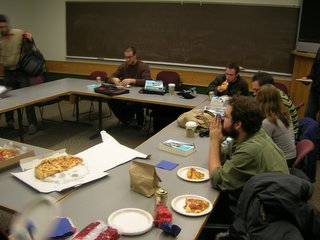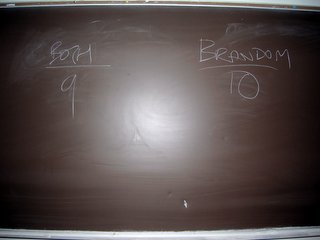The promise of pizza, beer, and talk about whether philosophy is continuous with science drew the largest crowd in workshop history to Cobb 103 tonight.
Jason B. opened with a short introduction to some central Quinean themes: Naturalism, empiricism, stimulus meaning, holism, the social character of meaning, and meaning behaviorism. He introduced the familiar central worry about Quine's epistemology: how can surface irritations be "clues to an external world" (22)? My rough reconstruction of the central worry goes as follows:
1. For something to count as a clue, to count as evidence, it must be capable of justifying claims.
2. Only something with "content" (conceptual, propositional?) is capable of justifying claims.
3. Surface irritations have no content.
4. So surface irritations cannot count as clues, as evidence.
We started discussion by taking up the issue of Quine's naturalism. There was some debate about what it meant to say that philosophy and science were "continuous". Chris F. claimed that there was a difference between Quine's naturalism and physicalism of a type- or token-identity sort. Aidan G. said he liked science though he thought he wasn't supposed to. Chris F. said that people he has talked to in CHSS didn't see how it was possible to deny the "philosophy is continuous with science" claim. David F. observed that one could do it simply by saying that philosophy was discontinuous with science. For example, one might think, with the logical positivists, that the job of philosophy is to clear away conceptual confusion and let the scientists get on with their important work. Or one might think, with Wittgenstein, that the job of philosophy is to expose latent nonsense as patent nonsense.
So in response to the question, "Is philosophy continuous with science?" we concluded: it depends on what one means by "science" and "continuous with". No one asked what "philosophy" or "is" meant.
Nat H. asked about Quine's analogy between the sharing of "sensory supports" between sentences with the arch (p.11). How, when the arch is "tottering on an earthquake", is a "base block...supported now and again, only by the other base blocks via the arch"? Isn't the base block supported primarily by the ground? Jason B. pointed out that in asking this, Nat H. was neglecting Quine's footnote to the analogy, which says:
"The analogies of the fabric and the arch are well supplemented by the more detailed analogy of the net which Hempel develops..."
Several workshop participants (including, I believe, Tucker M.), explained that we were not supposed to imagine the ground dropping away from underneath the arch, in which case the other blocks clearly would not be of any help, but instead to imagine the ground merely shaking. In such a case one of the base blocks might be held in place by the weight of the other blocks pressing down on it. That sounded plausible.
Stina B. then asked for an explanation of how Quine's argument against sense data (pp. 2-3) was supposed to be understood. Was it merely a worry about memory, or something more significant? Chris F. said he was going to ask just the same question. David F. glossed the question as asking whether Quine comes close, in his criticism of sense data, to an insight that would have helped him detect the problems with his own account of sensory irritations. Quine's comment that "immediate experience simply will not, of itself, cohere as an autonomous domain" might be turned against his own notion that sensory stimuli count as the basic clues we have of the external world. Robert B. asked if David's proposal was part of a Resolute Reading of Word and Object.
Chris F. then recalled a possible reading of Quine from John H.'s class on Quine and Davidson five years ago. What if, Chris F. asked, Quine's sensory irritations were token identical with contentful experiences? The contentful experiences would be bound up with man's conceptual sovereignty, holistic, and so on, while the irritations, qua physical events, would remain unchanged through reconfigurations of the conceptual scheme. Jason B. objected that this wasn't consistent with Quine's statements that the irritations (qua irritations?), not conceptually contentful descriptions of the irritations, were supposed to be clues (cues?).
At this point, Chris F., the Dionysian force animating the workshop, had to leave to catch the beginning of Lost. So we wound up discussion and proposed that we read the preface and the first chapter of Making it Explicit for next week.







